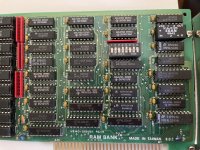First of all, let me thank all who responded to this issue regarding the development of drivers for LIM EMS cards. Chuck(G), I am sorry to say that the link you suggested doesn't seem to work; the /res/ seem to bomb out.
Yes, I know and acquired a Lo Tek card, but, found out from Eudimorphodon that the design was quite a bit different than the Boca or IBM RAMBANK cards of the 1980's. So, when the opportunity arose that I could find a similar type card to Boca or RAMBANK card then I would hop on to it. I did, however, the Memo 20000Xt card is suppose to be a clone of the IBM RAMBANK PC. I found a couple of ad's for the Memo, which projected itself as the affordable alternative to the IBM RAMBANK card. In addition, at the following website:
https://www.atarimagazines.com/compu...ion_Boards.php I found the Memo 2000X listed along with a listed manufacturer DFI or Diamond Flower Electric Instruments out of West Sacramento, CA. Of course, the company doesn't exist any more and I don't know if they were bought out by another company or just died away. Included with this post are two pictures: one is the Memo chips picture as shown in "Memo Chips.jpg" while the other is a listing of the chips and what they are according to what was found on the web from different dealers who are still selling these chips; "Memo chips definded.jpg". Note there is no manufacturer or FCC label on this card.
As I said, there is no known documentation on the web or print form and software for the Memo card. AD articles found on Google from sources such as PC Compute seem to point the Memo card to be a clone of the IBM PC/XT RAMBANK card. I have found AT users manual on the web for the AT-RAMBANK as an undeclared pdf that is not labeled by any manufacturer. The manual is written with the usual FCC declaration and enough covets to keep the buyer from determining who manufactured the manual and referring the buyer to the dealer to correct any problems that might arise. The interest in the manual was for me the addressing array seemed to match the first four switches of the Memo card. A table shows addresses that start at 208h and end at 2FAh. The table shows the 258h that I am using as 2 & 4 on with 1 & 3 off. So, yes it may be prudent to try the first four switches to see if all being turned on are addressing 208h as stated in the table. I'll leave the remaingin switches alone for now.


I need to point out that the Memo card is residing in another AT&T 6300 with its reversed addressing that was pointed out to me some time ago. The original Boca XT card that I have is addressed at 208h with E000h and seems to work fine in my first 6300. The current 6300 machine has addresses assigned at C800h for the MFM hard drive using 320h and D800h is the Lo Tek XT-CF card that works at 300h. I'll try the Checkit to see if it see the expanded memory. However, I don't think it will see it without the driver in place.
I have a Boca AT users manual paperback coming. I know there is a Boca XT manual and have picture of it; but I didn't see it for sale or pdf for it. Also I have an IBM RAMBANK PC users manual coming, paperback. Since this Memo is a clone of the IBM then maybe this manual will shed some light on the Memo and correct the addressing.


